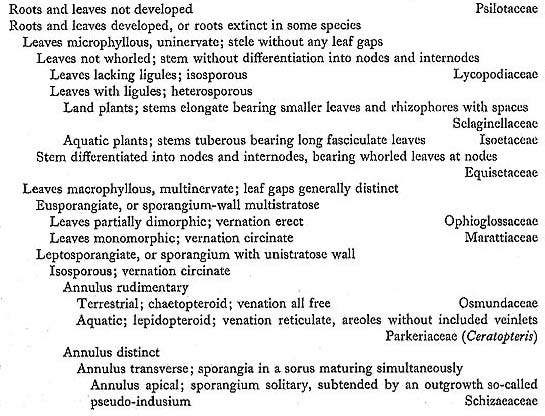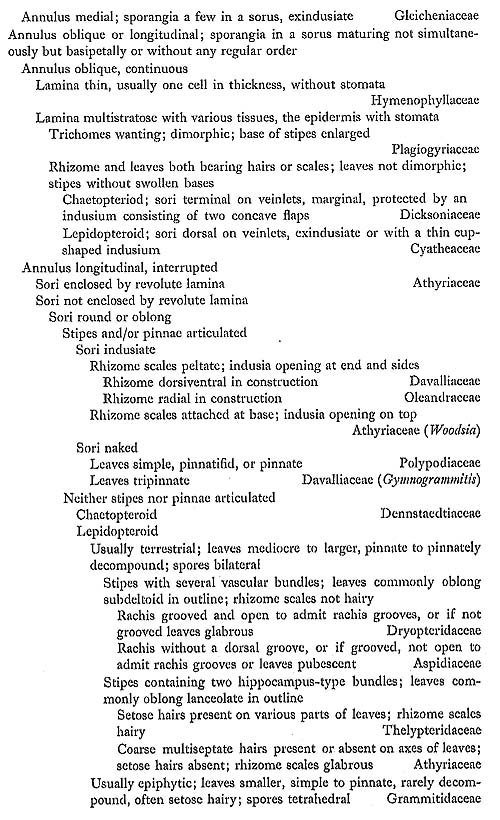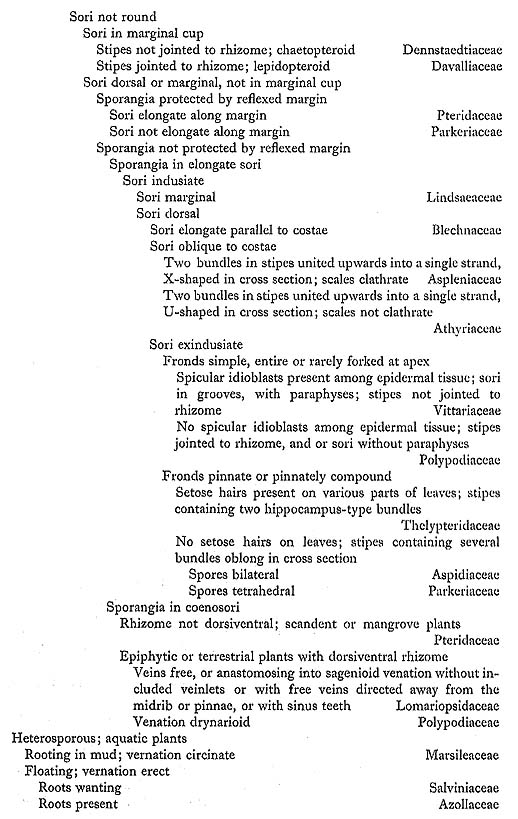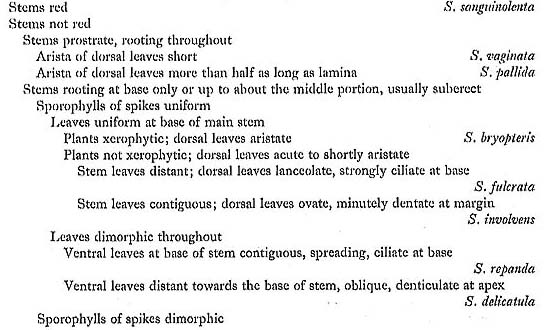AN ENUMERATION OF THE PTERIDOPHYTES OF NEPAL
Kunio IWATSUKI
| ( 1 / 6 ) |
IntroductionThe flowering plants of Nepal were comprehensively enumerated recently in Hara, Stearn and Williams (1978-81) in three volumes. Reporting on the ferns and their allies is far behind that on the flowering plants and there is no modern enumeration listing all the species known from Nepal. This work intends to provide a check list of all the known species of the pteridophytes in Nepal, mainly based on the specimens preserved in Japanese herbaria, especially in KYO and TI. The author made a botanical excursion to Nepal in 1972 as a member of the Uni-versity of Tokyo Botanical Expedition to the East Himalayas, and made observations in the Nepal and Darjeeling areas for about three months. He also made several botanical excursions to northern Thailand during 1965-1972 and to Yunnan in 1984 (Iwatsuki and Zan 1986) and 1987 (Iwatsuld et al. 1988), and noted many so-called Himalayan species growing in these areas. Phytogeographical comparisons were also made with species in Japan. Recently a great number of specimens have been collected, as will be briefly noted in the historical sketch. After compiling all information I have tried to prepare a critical list of the Nepalese ferns as a basis of further analytical studies of the species growing there. A general conspectus of the flora of Nepal was given by Stearn in Hara et al. (1978). In these brief introductory notes I will make a few additions to the information on fern taxonomy. History of Explorations and Studies of Nepalese FernsPteridophytes of Nepal were studied in the last century mostly by British botanists, and the results were published in many excellent papers. 'Species Filicum' by Hooker and later 'Synopsis Filicum' by Hooker and Baker marked a great advance in the knowledge of ferns, and the ferns of the Himalayas were comprehensively treated in these monumental works. Based on these great works, the Himalayan ferns were further revised by botanists who observed them in the field. One of the most intensive works among them was that by C. B. Clarke (1880). R. H. Beddome published his observations in the form of illustrations and then compiled his contributions in a handbook in 1883 with a supplement in 1892. C. W. Hope (1899-1904) made a detailed study on the ferns of northwestern India, which included a contribution to the elucidation of the pteridophytes of Nepal. In the first half of our century, fern classification made a great advance, though Himalayan botany was hardly active. The ferns of surrounding areas, especially those of China and Indochina were studied intensively, and classical Himalayan collections were revised in the course of these studies. Great contributions to the Chinese ferns were made by R.-C. Ching, and Indochinese ferns were revised by Tardieu-Blot and C. Christensen (1939-51). Ferns of Taiwan, which are systematically related to their Himalayan relatives, were studied first by B. Hayata and then by M. Tagawa in more detail. In the 1950s, when Nepal was opened to botanists from abroad, a new era of research on Nepalese ferns began. Many Japanese botanists visited and did a variety of botanical researches. Nakao, Namikawa, Kawakita and others made trips to Nepal and collected many specimens, including ferns which are now preserved in KYO. Some of these were studied by M. Tagawa. Professor H. Hara began the University of Tokyo Botani-cal Expeditions to the Eastern Himalayas, and eight expeditions of considerable size were sent from the University of Tokyo between 1960 and 1985. Numerous specimens of pteridophytes were brought to TI and the duplicates were dispersed to herbaria throughout the world. The present author took part in the fifth expedition in 1972. Collections of the first to fifth expeditions were enumerated and published in three parts in 1966, 1971, and 1975, and the pteridophytes were studied by M. Tagawa, H. Ito, M. Nishida, and the author. Kanai, Nishioka, and others stayed in Nepal for longer periods, and collected speci-mens with the collaboration of Nepalese botanists. Common weeds, especially in and around cultivated areas, often escape the eyes of botanists who pass such places rather quickly; only the botanists living in the country can make more detailed observations of such areas. Hence, the above botanists found many species which were not in the collections of the expeditions. Chiba University and Kyoto University sent several ecological expeditions to Nepal, and the ecologists collected a number of specimens including pteridophytes. Kyoto University's ecological expeditions explored western Nepal, and many interesting spec-imens were brought to KYO. Pteridophytes of the Chiba University expedition of 1963 were listed by Nishida (1966,69), though the later collections are not recorded in the literature. Toyama University sent pharmacognological expeditions to Nepal several times, and Namba, Mikage and others collected botanical specimens. Among the Japanese botanists, K. Suehiro collected a variety of pteridophyte spec-imens in 1976; his collections are in KYO. His primary interest was to analyse the vegetation in Nepal, but he collected many specimens of pteridophytes along the way. There are other Japanese who collected in Nepal and contributed their specimens to the major herbaria. More recently, Nakaike took part in the National Science Museum Cryptogamic Botany Expedition and collected in Nepal: he published checklists of Polystichum and Crypsinus in Nepal. Even in recent years, British botanists made expeditions to Nepal and Indian bota-nists made various explorations there. M. L. Banerji explored Nepal many times, and published a paper on the pteridophytes of Nepal in 1972. B. K. Nayar and his collabo-rators made contributions to the study of ferns of India, and included Nepalese ferns. A check list of the collections made by Zimmermann was prepared by A. H. G. Alston and C. E. B. Bonner (1956). The number of Nepalese botanists is growing and we can expect detailed botanical explorations by them in the near future. Scope of the Present StudyThe University of Tokyo Expeditions to the Eastern Himalayas yielded a variety of scientific contributions: the ferns of the first to fourth expeditions were enumerated with a collaboration of H.Ito, M. Tagawa, M. Nishida, and K. Iwatsuki in two parts in 1966 and 1971. The author took part in the fifth expedition, and the enumeration of the pteridophytes in the third contribution was prepared by him along with critical revisions of the first and second enumerations. After the sixth expedition, however, no enumerations were prepared for the collections, partly because a general enumera-tion of the flowering plants had been worked out. More detailed taxonomical studies are being carried out for the flowering plants, although we have no modern enumera-tion of the pteridophytes. The primary intention of this work is to enumerate the results of the identification of all the Nepalese pteridophytes collected by the University of Tokyo Expeditions. In addition, the comparative studies were extended to the materials preserved in the other herbaria, and the literature was screened. Thus, it is hoped this will be an enu-meration of every known Nepalese pteridophyte. Arrangements and AbbreviationsThe arrangement of the enumeration is in the order of the families recognized in Tagawa and Iwatsuki (1972), though some modifications are made; subfamilies of the Peranemaceae arc treated here as distinct families, recognizing both Dryopteridaceae and Aspidiaceae. An artificial key to the families will be given preceding the enu-meration. In each family a key to the genera is prepared, and in each genus a key to the species is given for the sake of identification. The synonymic list is restricted to necessary references. In every case, Clarke (1880), Beddome (1883, 1892), Hope (1899-1904), Tagawa (1955), H. Ito, Tagawa, Nishida, and Iwatsuki (1966,1971), and Iwatsuki (1975) are considered. Banerji (1972) was mostly recorded in Iwatsuki (1975) and some notes are given here on the species concerned. Many of the Zimmermann collections, on which Alston and Bonner (1956) are based, were examined, and a few comments will be made in this enumeration. The citations to the above literature are in abbreviated form as shown above, Other references are cited only when they are needed to recog-nize the species in Nepal. The specimens are listed without herbaria citation; most of them can be found in Japanese herbaria, especially KYO and/or TI. Many specimens are skipped when the field number is not available. In some cases, species without any Nepalese specimens are included, especially when it is highly probable that the species ia in Nepal. The Terrai area has been less minutely botanized, and additional widespread species may be found in this area. Habitats are only briefly recorded for each species as there are many species whose habitats are not given on the labels. In such cases, the habitats are estimated to be similar to the Yunnan and/or Thai habitats of the species, Altitudinal records are often treated as in the neighboring areas. Distributions are rather roughly noted, though Bhutan is fully recorded in order to make the phytogeographical interrelationships clearer. N India includes Sikkim, Dar-jeeling, Kashmir and others, and designations in China are variable. The recent explorations in SW China are comprehensive, and there are valuable contributions by R.-C. Ching, S.-K. Wu, K.-H. Shing, etc. Flora Xizangica I (1981) is an important reference, and I owe very much to it, though Ching & Wu's species concept is very narrow and strict. Notes are generally not given here, and further studies are postponed. Most of the species are recognized in the broader sense. At this stage of taxonomical studies, species should be analysed by applying modern techniques to elucidate their real nature. It is hoped that this enumeration will provide for a more detailed species analysis of the pteridophytes of Nepal. AcknowledgementsThis enumeration is based mostly on herbarium specimens. The author is thankful to all who botanized in Nepal and collected specimens in the severe conditions there; also to the herbarium staff members who keep the specimens in good condition and make botanical research possible in herbaria. The author has done herbarium studies in A AAU B BK BKF BM BO C CAL E G GH IBSC K KAG KYO KUN L MICH NSW OSA P PE PNH SAP SING TI TNS TOFO UC US, although his main research work was carried out in KYO and TI. He is grateful to the directors and curators of these herbaria. Artificial Key to the Families Known in Nepal
EnumerationLYCOPODIACEAELycopodium L.
Lycopodium serratum Thunb., Fl. Jap. 341, t. 38 (1784); D. Don, Prodr. Fl. Nepal. 19 (1825); Clarke (1880) 591; Tagawa (1971) 199. ——— Urostachys serratus (Thunb.) Hert., Bot. Arch. 3: 13 (1923), Ind. Lycopod. 81 (1949). Lycopodium herterianum Kümm., Magyar Bot. Lap. 26: 99 (1928); Tagawa (1971) 198; K. Iwats. (1975) 167. ——— Lycopodium sikkimense Hert., Bot. Jahrb. 43 Beibl. 98: 42 (1909) non K. Müll. (1861). ——— Urostachys sikkimensis (Hert.) Hert. ex Nessel, Lycopod. 52, t. 7, f. 1 (1939). ——— Urostachys herterianus (Kümm.) Hert, Ind. Lycopod. 64 (1949). Lycopodium selago L., Sp. Pl. 2: 1102 (1753); K. Iwats. (1975) 167.——— Urostachys selago (L.) Hert., Phil. J. Sci. 22: 180 (1923), Ind. Lycopod. 81 (1949). Lycopodium hamiltonii Spr., Syst. Veg. 5: 492 (1828); Clarke (1880) 590; K. Iwats. (1975) 166. ——— Lycopodium obtusifoliiim Hamilt. ex D. Don, Prodr. Fl. Nepal. 18 (1925), non Sw. (1806) ——— Urostachys hamiltonii (Spr.) Hert. ex Nessel, Lycopod. 68 (1939), Ind. Lycopod. 63 (1949). Lycopodium subulifolium Wall. ex Hook, et Grev., Icon. Fil. 1; t. 49 (1827); Tagawa (1971) 199. ——— Lycopodium setaceum Hamilt. ex D. Don var. siibiilifolizan Wall. apud Clarke (1880) 590. ——— Urostachys mbulifolius (Wall. ex Hook. et Grev.) Hert., Ind. Lycopod. 84 (1949). Lycopodium pulcherrimum Wall. ex Hook. et Grev., Icon. Fil. 1: t. 38 (1827); K. Iwats. (1975) 167. ——— Lycopodium setaceum Hamilt. ex D. Don var. piilcherrimum (Wall. ex Hook. et Grev.) Clarke (1880) 590. ——— Urostachys pulcherrimiis (Wall. ex Hook. et Grev.) Hert., Ind. Lycopod. 77 (1949). Lycopodium squarrosum G. Forst., Fl. Ins. Austr. Prodr. 86 (1786); Clarke (1880) 591; Tagawa (1971) 199. ——— Urostachys squanosus (G. Forst.) Hert., Bot. Arch. 3: 14 (1923), Ind. Lycopod. 83 (1949). Lycopodium phlegmaria L., Sp. Pl. 2: 1101 (1753); Clarke (1880) 592. Lycopodium veitchii Christ, Bull. Geogr. Bot. Mans. 1906: 141 (1906); Hert., Ind. Lycopod. 46 (1949); Tagawa (1971) 200; K. Iwats. (1975) 167. Lycopodium clavatum L., Sp. Pl. 2: 1101 (1753); Clarke (1880) 592; Hert., Ind. Lycopod. 11 (1949); Tagawa (1971) 198; K. Iwats. (1975) 166. Lycopodium cernuum L., Sp. Pl. 2: 1103 (1753); Clarke (1880) 591; Hert., Ind. Lycopod. 10 (1949); Tagawa (1971) 197; K. Iwats. (1975) 166. SELAGINELLACEAESelaginella Beauv. Alston, A. H, G. 1945. An enumeration of the Indian species of Selaginella. Proc. Nat. Inst. Sci. Ind. 11; 211-234.
Selaginella picta var. viridis Alston was noted from Nepal in Ching & S.-K. Wu in C.-Y. Wu, Fl. Xizang. 1: 7 (1983), though I have seen no specimen. Selaginella sanguinolenta (L.) Spring, Bull. Acad. Roy. Sci. Brux. 10: 135 (1843); Alston, Proc. Nat. Inst. Sci. Ind. 11: 215 (1945). ——— Lycopodium sanguinolentum L., Sp. PL 2: 1104 (1753). Selaginella pallidissima Spring, Bull. Acad. Roy. Sci. Brux. 10: 231 (1843); Alston, l.c. 216 (1945); K. Iwats. (1975) 168. Selaginella vaginata Spring, Mém. Acad. Sci. Belg. 24: 87 (1850); Alston, l.c. 217 (1945); Tagawa (1971) 201; K. Iwats. (1975) 169. Selaginella repanda (Desv.) Spring in Gaud., Voy. Bonite Bot. 1: 329 (1846); Alston, l. c. 217 (1945); K. Iwats. (1975) 169. ——— Lycopodium repandum Desv. in Lam., Ency. Suppl. 3: 558 (1814). Selaginella pallida (Hook. et Grev.) Spring, Bull. Acad. Roy. Sci. Brux. 10: 234 (1843); Alston, l.c. 218 (1945). ——— Lycopodium pallidum Hook. et Grev. in Hook., Bot. Misc. 2: 389 (1831), non Beyrich ex Gaud. (1826). Selaginella fulcrata (Hamilt.) Spring, Mém. Acad. Sci. Belg. 24: 171 (1850); Alston, l.c. 219 (1945). ——— Lycopodium fulcratum Hamilt. in D. Don, Prodr. Fl. Nepal. 17 (1825). Selaginella involvens (Sw.) Spring, Bull. Acad. Roy. Sci. Brux. 10: 136 (1843); Alston, l.c. 220 (1945); Tagawa (1971) 200; K. Iwats. (1975) 168. ——— Lycopodium involvens Sw., Syn. Fil. 182 (1806). Selaginella bryopteris (L.) Baker, J. Bot. 22: 376 (1884); Alston, l.c. 221 (1945).——— Lycopodium bryopteris L., Sp. Pl. 2: 1567 (1753). Selaginella delicatula (Desv.) Alston, J. Bot. 70: 282 (1932), Proc. Nat. Inst. Sci. Ind. 11: 222 (1945). ——— Lycopodium delicatulum Desv. in Lam., Ency. Suppl. 3: 554 (1814). Selaginella pennata (D. Don) Spring, Mém. Acad. Sci. Belg. 24: 257 (1850); Alston, l.c. 225 (1945); K. Iwats. (1975) 168. ——— Lycopodium pennatum D. Don, Prodr. Fl. Nepal. 18 (1825). Selaginella bisulcata Spring, Mém. Acad. Sci. Belg. 24: 259 (1850); Alston, l.c. 225 (1945); Tagawa (1971) 200; K. Iwats. (1975) 167. Selaginella chrysocaulos (Hook. et Grev.) Spring, Bull. Acad. Roy. Sci. Brux. 10: 232 (1843); Alston, l.c. 225 (1945); Tagawa (1971) 200; K. Iwats. (1975) 167. ——— Lycopodium chrysocaulos Hook. et Grev. in Hook., Bot. Misc. 2: 40 (1831). Selaginella chrysorrhizos Spring, Mém. Acad. Sci. Belg. 24: 244 (1850); Alston, l.c. 226 (1945); K. Iwats. (1975) 168. Selaginella kurzii Baker, J. Bot. 23: 249 (1885); Alston, l.c. 226 (1945); K. Iwats. (1975) 168. Selaginella tenuifolia Spring, Mém. Acad. Sci. Belg. 24: 253 (1850); Alston, l.c. 226 (1945); K. Iwats. (1975) 169. Selaginella ciliaris (Retz.) Spring, Bull. Acad. Roy. Sci. Brux. 10: 231 (1843); Alston, l.c. 227 (1945); K. Iwats. (1975) 167. ——— Lycopodium ciliare Retz., Obs. 5:32(1789). Selaginella monospora Spring, Mém. Acad. Sci. Bel. 24: 135 (1850); Alston, l.c. 228 (1945); Tagawa (1971) 200; K. Iwats. (1975) 168. Selaginella subdiaphana (Wall. ex Hook. et Grev.) Spring, Bull. Acad. Roy. Sci. Brux. 10: 232 (1843); Alston, l.c. 230 (1945). ——— Lycopodium subdiaphanum Wall. ex Hook. et Grev. in Hook., Bot. Misc. 2: 401 (1831). ISOETACEAEIsoetes L. Isoetes colamandrina L. f., Suppl. Pl. 447 (1781). EQUISETACEAEEquisetum L.
Equisetum arvense L., Sp. Pl. 2: 1016 (1753); Hauke, Nova Hedwigia 30: 435 (1978). Equisetum diffusum D. Don, Prodr, Fl. Nepal. 19 (1825); Clarke (1880) 594; Tagawa (1971) 197; K. Iwats. (1975) 166; Hauke, Nova Hedwigia 30: 428 (1978). N India, and W and SW China. Equisetum debile Roxb. ex Vaucher, Mém. Soc. Phy. Hist. Nat. Genéve 1: 387 (1822); Clarke (1880) 594; Tagawa (1971) 197; K. Iwats. (1975) 166. OPHIOGLOSSACEAE
Ophioglossum L. Ophioglossum petiolatum Hook., Exot. Fl. 1: t. 56 (1823); Clausen, Mem. Torrey Bot. Cl. 19 (2): 134 (1938); Nishida (1966) 453; H. Ito (1971) 201; K. Iwats, (1975) 170. Helminthostachys Kaulf. Helminthostachys zeylanica (L.) Hook., Gen. Fil. t. 47b (1840); Clarke (1880) 587; Bedd. (1883) 467, f. 292; Clausen, Mem. Torrey Bot. Cl. 19 (2): 108, f. 20 (1938); Nishida (1966) 453.——— Osmunda zeylanica L., Sp. Pl. 2: 1063 (1753). Botrychium Sw.
Botrychium lunaria (L.) Sw., Schrad. J. Bot. 1800 (2): 110 (1801); Clarke (1880) 587; Bedd. (1883) 469, f. 293; Hope, 15: 108 (1903); Clausen, Mem. Torrey Bot. Cl. 19 (2): 62 (1938); Tagawa (1955) 78; K. Iwats. (1975) 169. ——— Osmunda lunaria L., Sp. Pl. 2: 1064 (1753). Botrychium multifidum (Gmel.) Rupr., Beitr. Pfl. Russ. Rech. 11: 40 (1859); Clausen, Mem. Torrey Bot. Cl. 19 (2): 30 (1938); K. Iwats. (1975) 169. ——— Osmunda multifida Gmel., Nov. Comm. Acad. Sci. Peter. 12: 517, t. 11 (1768). ——— Scep-tridium multifidum (Gmel.) Nishida ex Tagawa, J. Jap. Bot. 33: 200 (1958); Nishida (1966) 454; H. Ito (1971) 201. Botrychium daucifolium Wall. ex Hook. et Grev., Icon. Fil. 2: t. 161 (1829); Clarke (1880) 587; Bedd. (1883) 469, f. 294; Clausen, Mem. Torrey Bot. Cl. 19 (2): 60 (1938). ——— Sceptridium daucifolium (Wall. ex Hook. et Grev.) Lyon, Bot. Gaz. 40: 457 (1905); Nishida (1966) 454; H. Ito (1971) 201. Botrychium lanuginosum Wall. ex Hook. et Grev., Icon. Fil. 1: t. 79 (1829); Hope, 15: 110 (1903); Clausen, Mem. Torrey Bot. Cl. 19 (2): 96 (1938); Banerji, J. Bomb. Nat. Hist. Soc. 58: 556 (1961); K. Iwats. (1975) 169. ——— Botrychium virginia-mim (L.) Sw. var. lanuginosum (Wall. ex Hook. et Grev.) Bedd., Suppl. Ferns Br. Ind. 28 (1876), (1883) 471, f. 295. ——— Osmundopteris lanuginosum (Wall. ex Hook. et Grev.) Nishida, J. Jap. Bot. 27:276 (1952); Tagawa (1955) 78. ——— Japonobotrychium lanuginosum (Wall. ex Hook. et Grev.) Nishida ex Tagawa, J. Jap. Bot. 33: 199 (1958); Nishida (1966) 453; H. Ito (1971) 201. On mountain slopes or on tree-trunks in forests at 1000-2500 m, rarely more than 3000 m, and as high as 4100 m (var. nepalense). MARATTIACEAEAngiopteris Hoffm. Angiopteris spp. OSMUNDACEAEOsmunda L.
Osmunda claytoniana L., Sp. Pl. 2: 1066 (1753); Clarke (1880) 582; Bedd. (1883) 449, f. 275; Hope, 15: 103 (1903); K. Iwats. (1975) 170. Osmunda japonica Thunb., Nova Acta Reg. Soc. Sci. Upsal. 2: 209 (1780); H. Ito (1966) 455, (1971) 202. PLAGIOGYRIACEAEPlagiogyria (Kunze) Mett.
Plagiogyria communis Ching, Acta Phytotax. Sin. 7: 122, 147, pl. 35, f. 2 (1958); K. Iwats. (1975) 180. Plagiogyria euphlebia (Kunze) Mett., Farng. Plagiogyria 10 (1858); Bedd. (1883) 129; Ching, Acta Phytotax. Sin. 7: 140 (1958). ——— Lomaria cuphlebia Kunze, Bot. Zeit. 1848: 521 (1848); Clarke (1880) 473. GLEICHENIACEAE
Dicranopteris Bernh. Dicranopteris linearis (Burm. f.) Underw., Bull. Torrey Bot. Cl. 34: 250 (1907); Tagawa (1955) 78; H. Ito (1966) 456, (1971) 202; K. Iwats. (1975) 170. ——— Poly
podium lineare Burm. f., Fl. Ind. 235, t. 67, f. 2 (1768); D. Don, Prodr. Fl. Nepal. 1 (1825). ——— Gleichenia linearis (Burm. f.) Clarke (1880) 428; Bedd. (1883) 4, f. 1. var. linearis. var. montana Holtt., Reinwardtia 4: 276 (1957). Gleichenia Smith Gleichenia gigantea Wall. ex Hook. et Bauer, Gen. Fil. t. 39 (1840); Hook., Sp. Fil. 1: 5, t. 3A (1844); Bedd., Ferns Br. Ind. t. 30 (1865); K. Iwats. (1975) 170. |












